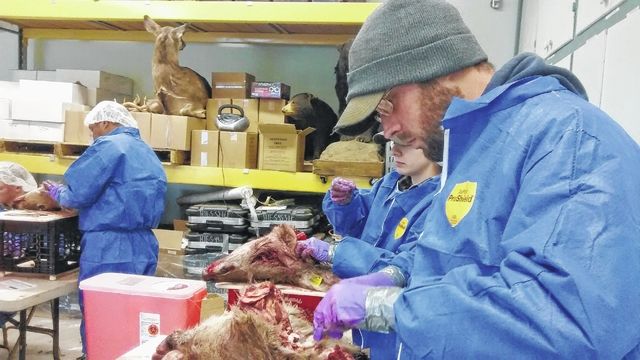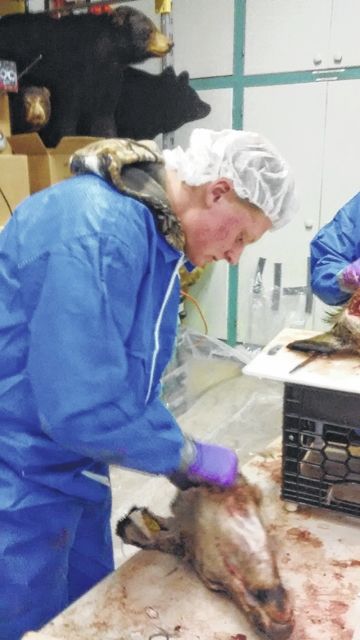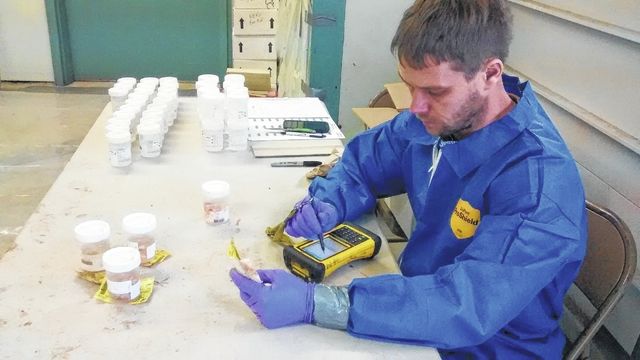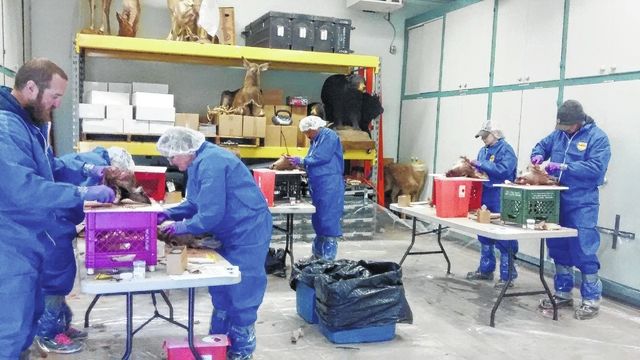Click here to subscribe today or Login.
With a serenade of country music in the background, Willy Wenner delicately maneuvered his scalpel into the base of a deer’s skull and removed a small portion of the brain stem.
Then, with surgical precision, Wenner, who is a wildlife biologist with the U.S. Department of Agriculture, neatly carved out two lymph nodes from the underside of the head.
It was a process repeated several hundred times last week as staff from the three government agencies convened on the Pennsylvania Game Commission’s region office in Dallas to collect samples to be tested for chronic wasting disease. The sampling was conducted over a two-day period
Chronic wasting disease is a degenerative brain disease that affects elk, mule deer and white-tailed deer. It’s transmitted by direct animal-to-animal contact through saliva, feces and urine that also can contaminate the environment. It’s always fatal to deer and elk.
The disease turned up in Pennsylvania in 2012 in both captive and free-ranging deer. But long before then, the threat of the disease spurred the PGC and the state and federal Department of Agriculture in 2002 to conduct yearly sampling to monitor for CWD.
The sampling is conducted during the firearms deer season as deer aging crews from the PGC collect heads from processors and deliver them to the region office. The CWD prions are found in the heaviest concentrations in the obex portion of the brain stem and the retropharyngeal lymph nodes, and in the northeast region more than 500 deer heads will be sampled this year.
After the obex and lymph nodes are collected, they’re placed in a vial and shipped to Pennsylvania Animal Diagnostic Lab in New Bolton.
Last year, more than 400 deer heads were sampled, and PGC biologist Kevin Wenner said there have been no positive tests for CWD in the region.
“We sample hunter-killed deer along with suspect animals reported by the public or our Wildlife Conservation Officers,” he said. “This year we moved sampling to the second week of deer season with the antlerless portion opening on Saturday there are more heads available from processors.”
When heads are brought to the region office, the accompanying harvest tag is scanned and the information stays with the sample during the testing process. Test results usually come back in March, Kevin said.
Since 2012, CWD has been found in deer in three locations in the state: a captive deer farm in Adams County (fall 2012); free-ranging deer in Blair and Bedford counties (2012 – 2014 firearms season, along with three roadkilled deer this year); and a captive deer farm in Jefferson County (spring 2014).
Because CWD has been found in captive deer, the USDA and PDA are involved in the sampling process. The PGC oversees wild deer while the state and federal agriculture departments regulate captive deer operations.
“That’s why we like to assist with this,” said Kristie Ludwig of the USDA Veterinary Services. “It’s a great opportunity with so many heads collected and brought to one location, and it also provides additional training.”
The opportunity to learn about the sampling process and wildlife biology in general is what brought 16-year-old Zack Redmond to the region office last week. Donned in protective gear, Redmond, who is a junior at North Pocono High School, sat a table next to personnel from the USDA removing brain stems and lymph nodes from deer heads.
Redmond hopes to pursue a career as a wildlife biologist with the PGC in the future.
“This is important to help get a handle on CWD and better protect the deer population,” Redmond said. “You get the hang of doing this pretty quickly, and it’s great because I’m learning about dissection, anatomy and biology.”








